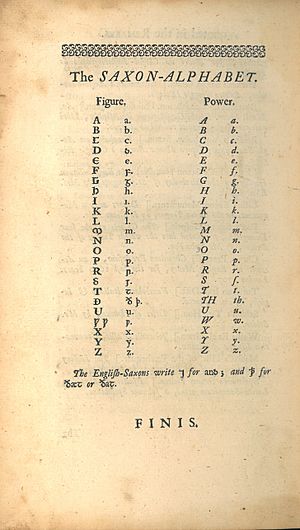Old English Latin alphabet facts for kids
The Old English Latin alphabet was the writing system used for the Old English language from about the 8th century to the 12th century. It usually had around 24 letters. Most of these letters came directly from the Latin alphabet, which is similar to the one we use today. However, some letters were special. Two letters, Æ and Ð, were changed versions of Latin letters. Two others, Ƿ and Þ, came from an older writing system called the runic alphabet. Some letters like Q and Z were hardly ever used, except for words from other languages. The letter K was sometimes used, but not always.
Contents
What Was the Old English Alphabet Like?
The Old English alphabet had many letters you would recognize. But it also had some unique ones! Here's a look at the letters that were commonly used:
| Letter |
|---|
| A, a |
| B, b |
| C, c |
| D, d |
| E, e |
| F, f |
| G, g |
| H, h |
| I, i |
| K, k |
| L, l |
| M, m |
| N, n |
| O, o |
| P, p |
| R, r |
| S, s |
| T, t |
| U, u |
| X, x |
| Y, y |
| Ƿ, ƿ |
| Ð, ð |
| Þ, þ |
| Æ, æ |
Letter Combinations (Digraphs)
Sometimes, two letters were put together to make a special sound. These are called digraphs. Here are some examples:
| Digraph |
|---|
| cg |
| ea |
| eo |
| gc (rare) |
| ie |
| io |
| sc |
| th (rare) |
| uu (rare) |
How the Alphabet Changed Over Time
Old English was first written using runes, which looked very different from our letters today. This runic alphabet was called futhorc.
Around the 8th century, things started to change. Irish Christian missionaries came to England and brought the Latin alphabet with them. They used a special style of writing called half-uncial script. This new way of writing slowly replaced the old runes.
Later, this half-uncial script changed into something called Insular script. This was a more flowing and pointed style. People used Insular script until the end of the 12th century.
Then, another change happened. A writing style from mainland Europe, called Carolingian minuscule, became popular. At the same time, the way words were spelled started to become more like the Old French alphabet. All these changes led to the development of Middle English, which was the next stage of the English language.
Special Letters You Won't See Today
The Old English alphabet had some cool letters that are not used anymore in modern English.
- Eth (⟨ð⟩): This letter looked like a 'd' with a line through the top. It was used for sounds like the 'th' in "this" or "that."
- Thorn (⟨þ⟩): This letter came from the runic alphabet. It looked a bit like a 'p' but with a longer top part. It was also used for 'th' sounds, like in "think" or "thin."
- Wynn (⟨ƿ⟩): This letter also came from runes. It made a 'w' sound, like in "water."
- Tironian et (⟨⁊⟩): This symbol looked a bit like the number seven. It was used as a shortcut for the word "and."
- Thorn with a crossbar (⟨ꝥ⟩): This was a special symbol for the word "þæt," which meant "that." It was a thorn letter with a line through its top part.
Sometimes, a short line called a macron (⟨¯⟩) was put over vowels. This usually showed that the vowel sound was long. But sometimes, it was used to show that an 'm' or 'n' sound was nearby, a bit like a tilde mark.


